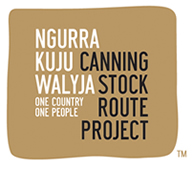One Road Interactive
The richness of the multimedia material recorded throughout the Project led the team to consider ways in which more of the footage, as well as the wealth of photographs, oral histories, historical records and other research could be accessed in Yiwarra Kuju: The Canning Stock Route. Partnering with the National Museum of Australia and multimedia production team Lightwell, FORM devised the concept for One Road, which was developed over 12 months.
Alfred Canning’s eponymous stock route snakes across the 10 multi-touch tabletop screens of One Road, an 8 metre long multimedia installation that is the signature piece of Yiwarra Kuju: The Canning Stock Route.
Canning’s intricately drawn map is outlined by red sand — as if it’s been rolled out on the desert floor. Visitors draw pictures and patterns in the sand with their fingers. The movement of ants and lizards animates its surface. A blind mole unexpectedly surfaces from its burrow. A majestically iridescent rainbow serpent stops visitors in their tracks. Interestingly, it’s the only thing in One Road that visitors can’t manipulate.
For emerging filmmaker Curtis Taylor, who produced films for One Road, such multi-layered storytelling allows the meaning of the old people’s stories, and their feeling for Country, to resonate more deeply with visitors.
You can see the person telling the story and the Country where it happened — how it looks, the landscape. You see it, not just hear about it. I think that’s the thing that hits people. They can see it and they think, ‘Oh I’m there. I’ve been there,’ because they’ve seen it with their own eyes. And that’s the way we’re thinking about it now. Returning to Country, you can’t put a price on it.
Curtis Taylor, 2010

